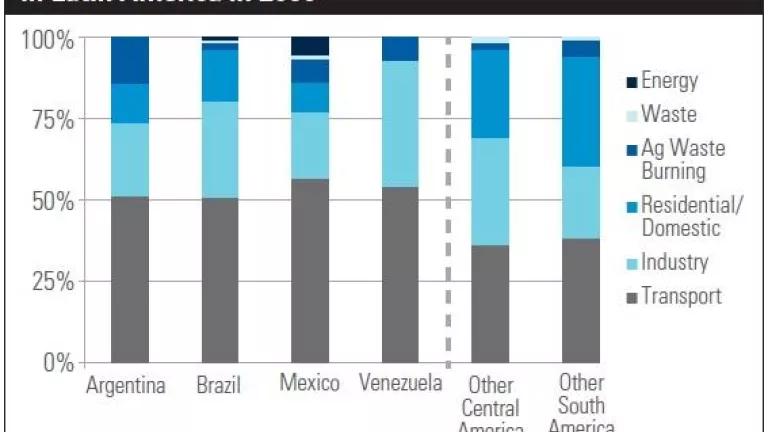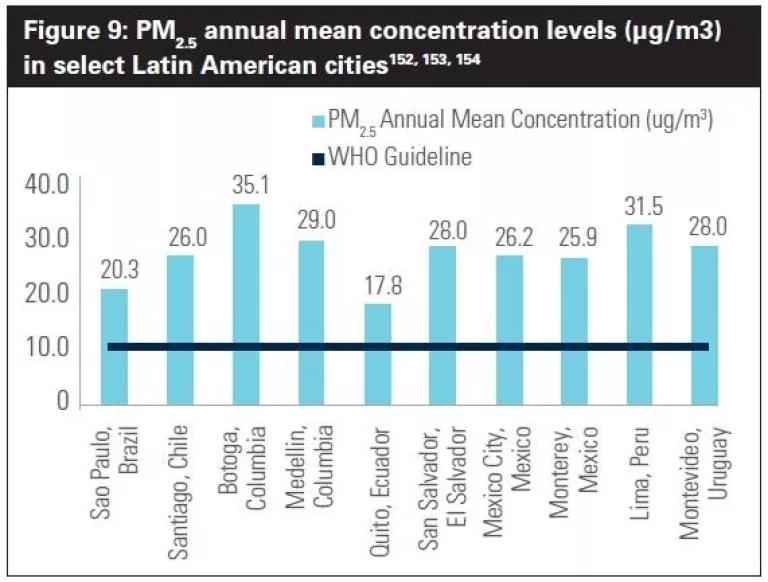Reducing Black Carbon Emissions Is a Win-Win for Public Health and Climate in Latin America

From Dumping Dirty Diesels in Latin America, page 17.
Today at the UN climate conference in Lima, Peru, NRDC is releasing a new report that focuses on a serious threat to both public health and climate in Latin America: black carbon. A recognized carcinogen and potent pollutant, black carbon is emitted by diesel vehicles throughout the region, exposing millions of people to toxic air and further aggravating climate change. The report finds that, unfortunately, most countries in Latin America do not adequately monitor or try to combat black carbon. The good news is that proven solutions exist, and the report identifies key strategies that Latin American governments can pursue to significantly reduce black carbon emissions: a combination of cleaner fuels, vehicle emission standards and established technologies. Doing so will help millions of people in the region breathe easier and reduce greenhouse gas emissions at the same time, proving to be a win-win for public health and climate change efforts.
The report, Dumping Dirty Diesels in Latin America: Reducing Black Carbon and Air Pollution from Diesel Engines in Latin American Countries,” which was co-authored with experts at Gladstein, Neandross and Associations (GNA), begins by summarizing existing research into the global and Latin America-specific impacts that black carbon has on climate and public health. It then dives into more detailed, original research looking at air quality, air quality monitoring systems, vehicle fleet profiles, vehicle fleet growth, vehicle regulations and fuel regulations in 15 Latin American countries.* The results of this research are telling of the gravity of the problem—and also of the extent of the benefits that the solutions could bring.
Black carbon is a major component of diesel engine exhaust—the black, sooty smoke that spews from tailpipes of dirty diesel cars and trucks. And it’s not good for you. Health experts have found ties between exposure to black carbon and decreased vascular function and respiratory problems, including aggravated asthma, decreased lung function and lung inflammation. The World Health Organization has determined that diesel exhaust, outdoor air pollution and particulate matter (which includes black carbon) cause cancer.
Black carbon is also not good for the climate. In fact, scientists have identified black carbon as the second most powerful contributor to climate change after carbon dioxide. As a short-lived climate pollutant (SLCP), black carbon emissions last a matter of days in the atmosphere, meaning its effects can be felt almost immediately. Fortunately, that means that the benefits of reducing black carbon emissions can be felt almost immediately as well.
Globally, open biomass burning is the largest source of black carbon emissions. However, in Latin America the largest anthropogenic source of black carbon is the transportation sector. Our research found that vehicle fleets in many of these 15 countries are growing at very high rates, indicating that unless solutions are implemented, more and more people will be exposed to black carbon emissions.
When we surveyed existing research about black carbon’s impacts on both climate change and public health, we and our partners at GNA found that—in contrast to global information—data about these impacts specifically in Latin America was quite sparse. Much more study needs to be done on both topics to understand the type and extent of the effects that black carbon emissions in Latin America are having on people and the environment. Nevertheless, enough data does exist to show that the problem is serious and warrants government action.
Some of our more interesting findings of the country-specific research include:
- only nine of the 15 countries monitor for fine particulate matter emissions (which covers black carbon);
- the air quality in all of the ten major cities that measure for particulate matter and fine particulate matter exceeded World Health Organization (WHO) recommended levels;
- Brazil, Mexico and Argentina combined have 80 percent of the vehicles in Latin America;
- yet the countries with the highest growth rate in vehicle fleets were Honduras and Nicaragua;
- Chile and Mexico are the only countries with stringent vehicle emissions standards; and
- only Chile has fuel quality standards strict enough to allow for major reductions in black carbon.

From Dumping Dirty Diesels in Latin America, page 18.
As I mentioned above, the good news is that proven strategies exist to significantly reduce black carbon emissions. In our report, NRDC and GNA recommend a three-part “systems” approach, which addresses emissions from both new and older vehicles. First, countries can adopt fuel quality standards requiring ultra-low sulfur content in diesel fuels. Second, countries can require stringent vehicle emissions standards, which would encourage the installation of emission control equipment on diesel engines such as diesel particulate filters, or promote alternative-fueled vehicles such as electric hybrids. Together these two strategies have reduced black carbon emissions from new vehicles by as much as 95 percent in other countries.
Complementing those two strategies, the third part of the system recommends that governments provide incentives to replace the oldest, most polluting trucks with cleaner, more fuel-efficient models. Interestingly, Colombia and Chile do this now. Further, 45 Latin American cities have implemented new bus routes that use clean buses and are replacing high-emitting buses.
In addition, our research clearly showed the importance of robust air quality monitoring systems in making policymakers and the general public aware of the high levels of dangerous emissions in their cities and countries. Governments can establish better air quality monitoring throughout the region, and share experiences and knowledge while doing so.
Finally, establishing other sustainable urban planning solutions such as Bus Rapid Transit (BRT) or Low Emission Zones (LEZs) can significantly help alleviate some of the congestion and air pollution in the transportation sector.
Black carbon emissions are a major threat to public health and climate around the world. Latin American countries have an opportunity to reduce those emissions drastically, using proven solutions in the transportation sector—the region’s largest source of black carbon.
By requiring cleaner fuels and lower vehicle emissions, and replacing the oldest and dirtiest vehicles with newer, efficient ones, governments can help millions of people breathe easier—and simultaneously help combat climate change.
* Argentina, Brazil, Bolivia, Chile, Colombia, Costa Rica, Ecuador, El Salvador, Guatemala, Honduras, Mexico, Nicaragua, Paraguay, Uruguay and Venezuela.

